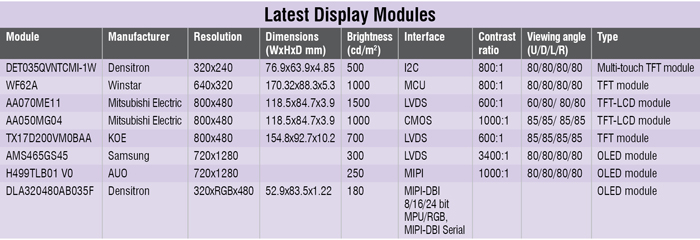We have all seen the transition from CCFT- to LED-backlit LCD modules, and the many benefits it provides for design engineers working on incorporating display technology into their devices. Modern displays, such as TFT and OLED, are evolving with promising designs for tomorrow, including the integration of new high-speed interfaces to handle the emergence of very-high-resolution imaging needs and the possible elimination of backlight in E-Ink displays. Overall, displays for embedded systems have evolved well enough to help design efficient and better products, often directly affecting the duration of the design cycle itself. Let’s see how.

Ready-to-deploy solutions
The choice of which embedded display to use could be a complex decision to figure out, especially for those who are new to integrating an embedded display into their design. Vendors have announced new all-in-one display products that cater to the requirements of a design engineer developing from industrial to consumer applications, with the main aim being to make the design process faster. These displays are engineered to integrate anything from power supplies to integrated processors. They include all the necessary components and integrate various functions like switch, UART, USB, SPI, I2C and PWM, along with SD card storage, to allow for large storage capabilities.

Ravi Pagar, regional director–South Asia, element14 India, says, “The all-in-one offerings reduce time-to-market and development costs. Engineers can quickly integrate multiple functionalities into their next design and also upgrade their designs, quite simply. These ready-to-deploy solutions can be adopted for products in various areas like industrial, consumer electronics and telecommunications.”
Upgrade for mono STN LCD modules. If you do not have much experience on TFT module development, and you want to upgrade your mono LCD display to a TFT, there is no need to worry about microcontroller unit (MCU) limitations. TFTs with integrated processors are available for upgrading mono displays to colour TFT displays, saving R&D engineers time and accelerate the product development procedures.

These latest ‘clever’ TFTs do not require any modification to the existing firmware and circuit on your PCB. For instance, Winstar’s WF35M allows the designer to implement colour TFT without having to redesign the TFT firmware and circuit. You can easily switch to TFT with a simple procedure, avoiding too many I/O, without using an expensive high-performance CPU or MCU. These TFTs eliminate the need for using FPC at the client’s end, thereby adding to the savings for your bill of material (BOM) costs for final products.

Onboard video processing for easier integration. Systems having a combination of video processing functionality built directly into the screens have made it possible for easier integration with a number of applications. These display modules, like 4D System’s 4DLCD-FT843 and FTDI’s VM800B, are highly advanced intelligent SPI displays, based on integrated video engine and amplifier-enabled audio, providing low-cost display solutions for your embedded designs.
The integrated engine offloads the host processor and provides a variety of graphics features. Besides, various interfacing options allow different hosts to be connected directly to the displays, providing a powerful set of audio and graphics features to the host using the on-board audio/video engine. These modules are best suited for requirements of various HMI applications, including industrial control terminals, intelligent instruments, data acquisition and analysis, medical products and network terminals.
TFTs with enhanced optics
Displays combining exceptional projected-capacitive-touch (PCT) technology with industrial-grade TFTs are able to offer higher transmissivity and unlimited controller-dependent multi-touch capability. Now we have a combination of high resolutions with extremely compact form factors up to depths as low as 4.6mm, enabling the design of even thinner devices or providing space for integrating more components.

Modules like those in Densitron’s DET035QVN series have improved TFTs with ultra-wide-view (UWV) polariser solution, increased viewing angles in each direction with greatest colour consistency, which is well suited for use in high-end, graphics-rich applications, for both fixed and mobile devices. And they consume as low as 2.8W.
If we talk about mono TFTs, the latest monochrome models with TN-positive LCD applied in the active-matrix TFTs are able to provide brightness as high as 1000-1500 nits, and high contrasts as much as 800:1 with short response times. These models, like the Winstar’s Mono WF57S, are superior alternatives to traditional monochrome LCD modules.
Thin-glass substrate EPD. Based on new thin-glass TFT technology, the latest E-Ink or electronic paper display (EPD) modules are catering to the demands of portable consumer electronics products that are much lighter and thinner as compared to other standard displays. These weigh around 50 per cent lighter than an equivalent glass-based TFT and are 50 per cent thinner.







Hello sir,
I want USB based OLED development kits may i know the vendors provided these kits and if required i also need certain display modules used in present embedded systems.
Let me know more about led display unit